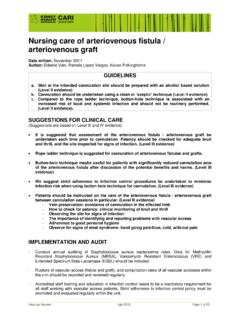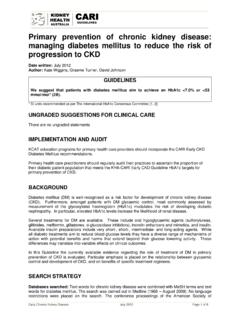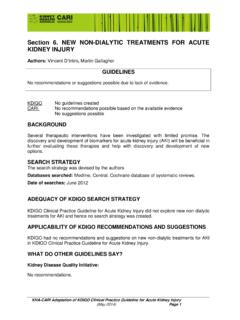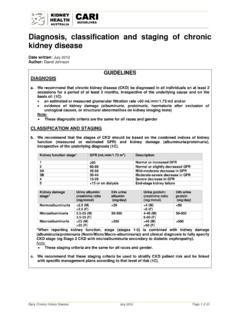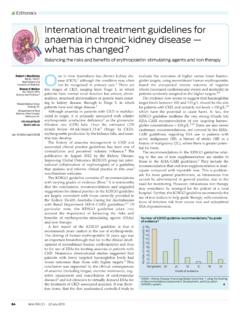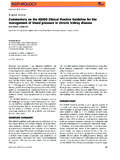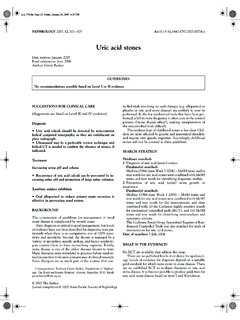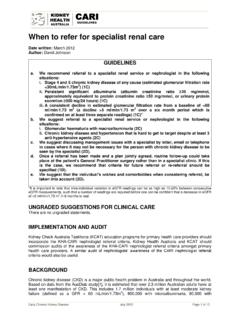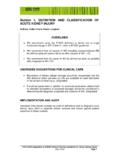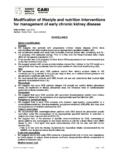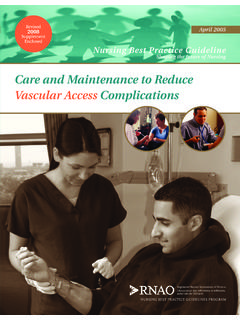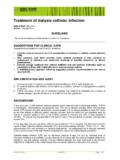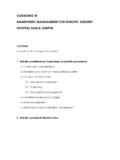Transcription of Haemodialysis anticoagulation and adequacy
1 The CARI Guidelines Caring for Australians with Renal Impairment Dialysis adequacy Haemodialysis (July 2005) Haemodialysis anticoagulation and adequacy Date written: November 2004 Final submission: July 2005 GUIDELINES a. No clear differences in Haemodialysis adequacy results have been demonstrated using standard unfractionated heparin and low molecular weight heparins. (Level II evidence, limited data) b. No differences in dialysis adequacy results are achieved using different low molecular weight heparins. (Level II evidence, limited data) c. There is no clear difference in the risk of thrombosis or haemorrhage with low molecular weight heparins compared with standard heparins, although the results of individual studies have been quite variable.
2 (Level I evidence) SUGGESTIONS FOR CLINICAL CARE (Suggestions are based on Level III and IV evidence) Low molecular weight heparins (LMWHs) have been suggested to have a number of other potential benefits with regard to bleeding risk, anticoagulant efficacy, risk of heparin-induced-thrombocytopaenia and lipid profile. These benefits remain unproven in patients on dialysis, with inconclusive and sometimes conflicting data available from randomised controlled trials (RCTs) (Lim et al 2004). LMWHs are simpler and more convenient to use given their once-only bolus method of administration; this may be an important consideration for some centres and some groups of patients.
3 (Opinion) This convenience is balanced by the substantially higher cost of these agents compared with unfractionated heparin. Until more data directly comparing the two becomes available, individual units should make a decision based on whether the extra cost can be justified by the issues of convenience. (Opinion) LMWHs have a limited duration of action, so a single bolus injection may not provide adequate anticoagulation for long dialysis sessions ( overnight dialysis). Background Haemodialysis is a life-sustaining therapy for individuals with end-stage kidney disease (ESKD). The treatment involves the passage of the individual s blood through an extracorporeal circuit, and anticoagulation is required to prevent clot formation and interruption of the Haemodialysis session.
4 The CARI Guidelines Caring for Australians with Renal Impairment Dialysis adequacy Haemodialysis (July 2005) Thrombosis in the dialysis lines may result in suboptimal dialysis and thus reduce dialysis efficiency. Similarly, coating of the dialysis membrane by microthrombi can potentially impair dialysis adequacy . Traditionally, anticoagulation during Haemodialysis has been achieved using unfractionated heparin (UFH) but more recently, a variety of LMWHs have been shown to have similar or better risk-benefit ratios when used as systemic anticoagulants for other conditions in the non-kidney disease population (Petersen et al 2004; Quinlan et al 2004).
5 This guideline will examine the effects of different intradialytic heparin regimens on Haemodialysis adequacy . Search strategy Databases searched: MeSH terms and text words for dialysis were combined with MeSH terms and text words for adequacy and anticoagulation and then combined with the Cochrane highly sensitive search strategy for randomised controlled trials. The search was carried out in Medline (1966 July Week 2 2004). The Cochrane Renal Group Trials Register was also searched for trials not indexed in Medline. Date of searches: 27 July 2004. What is the evidence? Saltissi et al (1999) randomised 36 adult patients undergoing 3 times-weekly maintenance dialysis therapy using cellulose-based hollow fibre dialysers to receive either a bolus of enoxaparin sodium (Clexane) (1 mg/kg body weight) or to continue with unfractionated heparin (50 IU/kg bolus then 1000 IU per hour infusion) for 12 weeks.
6 The two groups then crossed over for a further 12-week period. Although the primary parameter of interest was efficacy and safety with regard to coagulation, Kt/V values were available for only 20 patients. The mean Kt/V on Clexane was compared with using unfractionated heparin (p = ). Polkinghorne et al (2002) randomised 21 patients undergoing 3 times-weekly maintenance Haemodialysis to either boluses of dalteparin (2500 units), enoxaparin (40 mg) or danaparoid (34 units/kg) for 4 weeks. The purpose of the study was to collect pharmacokinetic data but urea reduction ratios were measured and analysed. Overall, there was no significant change in the urea reduction ratio over the course of the study for any of the regimens analysed.
7 Stefoni et al (2002) performed a randomised cross-over trial in which 28 patients on hemodialysis and 26 on hemodiafiltration were administered standard heparin during dialysis for 18 months. In the following 18 months, they were given LMWH during dialysis. The authors concluded that routine use of LMWH during hemodialysis is a safe and effective alternative to unfractionated heparin and Kt/V and URR were not significantly different between either phase of the trial. However, this trial had inadequate allocation concealment, method of randomisation and blinding and is considered to be low quality Level II evidence. The CARI Guidelines Caring for Australians with Renal Impairment Dialysis adequacy Haemodialysis (July 2005) A meta-analysis of 11 randomised trials (Lim et al 2004) comparing various LMWHs with unfractionated heparin found no difference in the risk of bleeding events (RR , 95% Cl: ), vascular access compression time (weighted mean difference , 95% Cl: ) or circuit thrombosis (RR , 95% Cl: ).
8 Of note, most of the included studies were of poor quality, had a high degree of variability in design and dosage, and a relatively short follow-up period. The study results were also highly variable for both endpoints (p test for heterogeneity , I2 = and , respectively). LMWHs do not seem to reduce dialysis adequacy , with no change in haemodialyser fibre bundle volume seen in patients after a change from unfractionated to LMWH (Lai et al 1996). Summary of the evidence Little data is currently available regarding the effect of different anticoagulant regimens on Haemodialysis adequacy , with a total of 63 patients enrolled in 3 small randomised controlled trials of poor quality.
9 In these studies, the use of different types of heparin regimens has not been shown to influence measures of dialysis adequacy . This is true when enoxaparin is compared with standard unfractionated heparin, and also when it is compared with dalteparin and danaparoid but the data limitations mean that a significant difference cannot be excluded. More data is available regarding the effects of different heparin subtypes on the risk of haemorrhage and thrombosis in a recent meta-analysis of 11 trials. No difference between the agents was identified, however, the included studies were generally of poor quality and generated highly variable results.
10 What do the other guidelines say? Kidney Disease Outcomes Quality Initiative: No recommendation. British Renal Association: No recommendation. Canadian Society of Nephrology: No recommendation. European Best Practice Guidelines: No recommendation. International Guidelines: No recommendation. Implementation and audit Consideration should be given to ongoing measurement of adequacy (either locally or by database ANZDATA) in those patients changed over to LMWH. The CARI Guidelines Caring for Australians with Renal Impairment Dialysis adequacy Haemodialysis (July 2005) Suggestions for future research 1.
